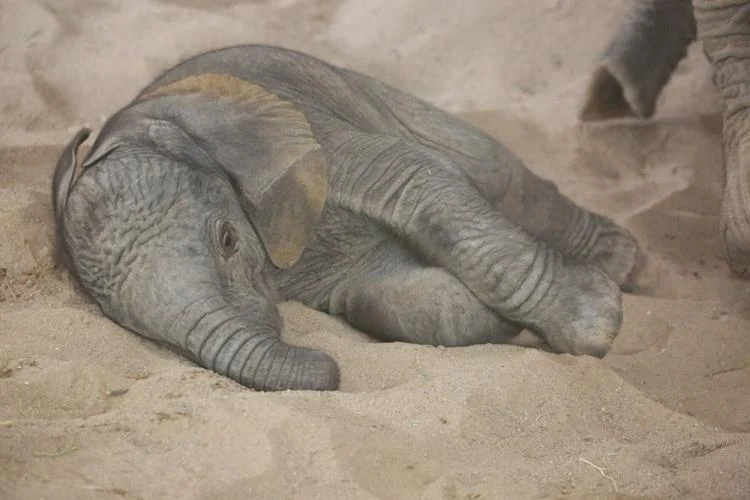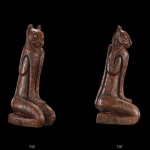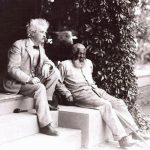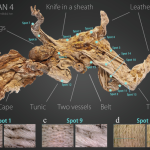A Heart-Wrenching Journey: The Story of an Orphaned Baby Elephant’s Survival Against All Odds

Introduction: A Shocking Discovery
In the vast and unforgiving wilderness, a tragedy unfolded that would forever change the life of a baby elephant. The morning was silent, the sun casting a soft glow over the dry plains. But beneath this peaceful exterior, an unimaginable heartbreak had taken place. A tiny elephant calf, no older than a few months, was found alone, trembling beside the lifeless body of its mother. The herd had disappeared, leaving the calf abandoned, lost, and grieving in the wilderness.
The baby elephant, fragile and vulnerable, stood in complete isolation, unable to comprehend the loss of the one creature who had given it life and protection. A tragedy that few will ever witness in their lifetime, this baby elephant’s story quickly became a symbol of loss, resilience, and the crucial need for wildlife conservation.
The Heartbreak of Abandonment
In the wild, the survival of a calf is intricately tied to the love, care, and protection it receives from its mother. For elephants, this bond is especially crucial. Elephants are social creatures, living in complex family structures, where each member of the herd plays a vital role in the survival of the young. The loss of a mother, especially in the absence of the herd, is a devastating event for any calf, and it’s a loss that can often lead to despair and a fight for survival.
The heart-wrenching sight of this baby elephant, trembling beside its deceased mother, is one that weighs heavy on the hearts of all who witness it. The isolation and grief this young calf experienced were unimaginable, with no other elephants to turn to for comfort, no other members of the herd to protect it.

The Role of the Herd in Elephant Society
Elephants live in matriarchal societies, where the oldest female elephant leads the herd. The structure of elephant herds is built on cooperation, trust, and mutual care. Each member contributes to the safety and upbringing of the younger elephants. This communal care is vital for the survival of the young calves, as they rely on the experience and wisdom of the herd to learn the ways of the wild.
In the case of this orphaned calf, the absence of the herd was felt more than ever. Without the protection of the adult elephants, the calf was exposed to dangers it couldn’t comprehend. The maternal bond within elephant societies is extraordinary, with allomothers (female elephants who are not the biological mother) stepping in to help raise calves. But in the absence of such support, this little elephant was left with no one to guide it.
The tragic reality of an orphaned elephant is that without the guidance of the herd, survival becomes an uphill battle. The baby elephant’s chances were slim, and that is why the arrival of rescuers was so critical.
The Emotional Impact of Rescue Operations
When the team of dedicated rescuers arrived on the scene, they were met with an emotional sight: the baby elephant, alone and frightened, beside its mother’s lifeless body. The sight was enough to bring tears to the eyes of even the most seasoned wildlife conservationists. This wasn’t just a rescue; it was a mission to save a soul in desperate need of care.
For the rescuers, this moment was both heart-wrenching and deeply motivating. The urgency to act was clear—this calf needed nourishment, comfort, and protection, or it wouldn’t survive the wilderness alone. The heartache of witnessing such loss was matched only by the determination to save the baby elephant from a future of suffering.
As the team approached, the elephant hesitated, its body trembling. This wasn’t just a physical trauma; it was an emotional wound that would take time to heal. But slowly, the baby elephant began to trust, understanding that the humans before it were here to help.

A New Beginning: The First Steps Toward Healing
The first hours after rescue were crucial. The baby elephant, traumatized and malnourished, needed immediate care. The rescuers set about cleaning its wounds, offering food, and giving it the warmth and comfort it so desperately craved. The first step in healing wasn’t just physical; it was emotional.
Over time, the baby elephant’s resilience began to shine through. It started to trust its caretakers, nudging them for food, and responding to their gentle voices. Each step of recovery was a small victory. For the rescuers, the emotional impact of this progress was immeasurable. They had not only saved a life but also brought hope back into the heart of a creature that had known nothing but pain and abandonment.
The Role of Human Intervention in Wildlife Conservation
While the best place for elephants is undoubtedly the wild, there are times when human intervention becomes necessary. This baby elephant’s story is one such example of how human involvement can make the difference between life and death. Conservationists play a vital role in rescuing orphaned animals, rehabilitating them, and preparing them for a potential return to the wild.
The rescue and rehabilitation process involves much more than just feeding and caring for the animal. It’s about providing the baby elephant with the tools it needs to thrive once again. This means creating a supportive, safe environment, restoring trust, and helping it overcome the trauma it’s experienced. For the baby elephant, this new beginning was only possible because of the intervention of dedicated conservationists who cared enough to act.

Healing from Trauma: The Baby Elephant’s Recovery
As the days passed, the baby elephant’s recovery accelerated. It began to show signs of improvement—its wounds healed, it gained strength, and it slowly started to show curiosity and playfulness. For the first time since its traumatic abandonment, it experienced moments of joy, running and playing in the rehabilitation area with the other young elephants.
However, the emotional healing process was far from complete. The trauma this calf had endured would stay with it for a long time, and it would take time for it to fully trust again. But each step forward was a step toward a brighter future. The bond between the calf and its caretakers grew stronger, but the goal was always to help the elephant reconnect with the wild, where it truly belonged.
The Long Road to Rehabilitation and Reintegration
Rehabilitation is not a quick process, especially for animals that have experienced trauma. For elephants, it involves much more than just physical recovery. Elephants are highly social creatures, and much of their healing comes from learning to interact with others of their species.
The road to reintegration into the wild is long, with each elephant’s path being unique. For this baby elephant, the journey will involve learning how to survive in the wild, how to find food, how to recognize danger, and how to interact with other elephants in a meaningful way. It’s a process that requires patience, dedication, and understanding. But with the right guidance, this baby elephant will one day be able to return to the wild, to the life it was meant to live.
The Importance of Wildlife Conservation
The rescue of this baby elephant is a shining example of why wildlife conservation matters. Elephants, like many other species, face numerous threats in the wild, from habitat loss to poaching to human-wildlife conflict. The survival of these majestic creatures is at risk, and it is up to us to ensure their future.
Conservation efforts help to safeguard the habitats of elephants, provide protection from poaching, and support the survival of orphaned or injured animals. Without these efforts, the stories of these elephants would be ones of loss and extinction, rather than resilience and hope.

Conclusion: A Story of Hope and Resilience
The story of this orphaned baby elephant is one of heartbreak, but also one of incredible resilience. From the devastating loss of its mother to the hope brought by its rescuers, this calf’s journey represents not just survival, but the power of compassion, the will to live, and the importance of protecting wildlife.
As we look to the future, let us remember that each story like this is a call to action. It is a reminder that we all have a role to play in ensuring the survival of endangered species. By supporting wildlife conservation, spreading awareness, and taking action to protect these animals, we can help make sure that future generations of elephants and other wildlife have a fighting chance.











